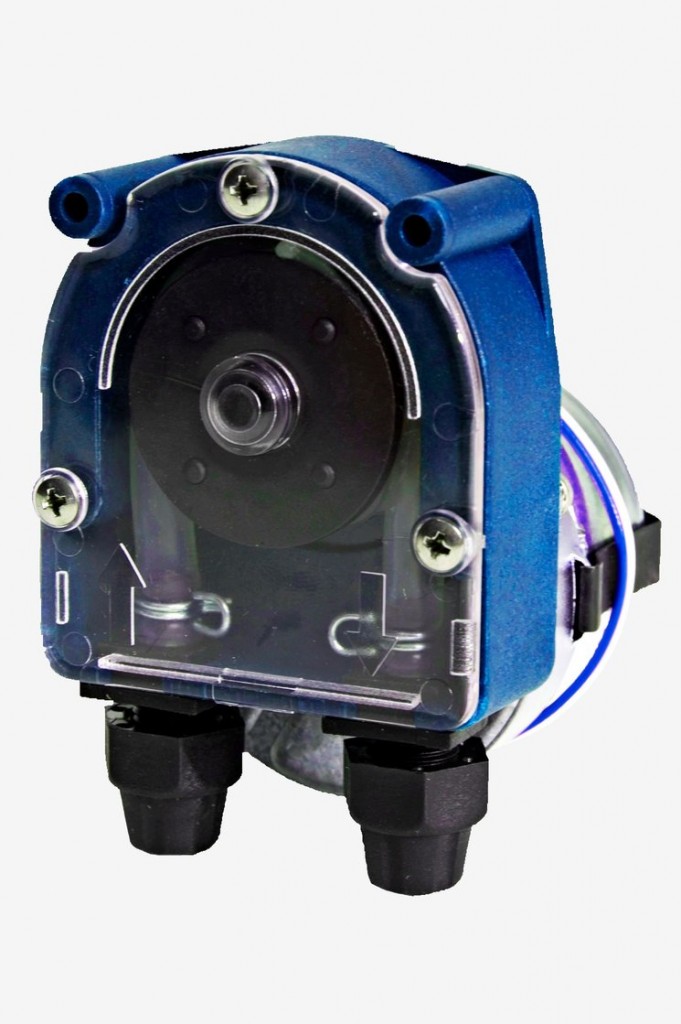Different Types of Pumps – Peristaltic Pumps
Peristaltic Pumps
A Peristaltic Pump is a type of Positive Displacement Pump. A rotor is used to squeeze a leak-proof tube or hose, thereby forcing the pumped fluid through the hose. The fluid being transported does not come into direct contact with any parts of the pumping mechanism. This makes it ideal for pumping fluids that either need to be sterile or should not leak into the environment.

Principle of Operation
There are two primary components to the pump: the hose and the rotor. The hose, which must be made of a tough, chemical-resistant material that allows no leakage of air or liquid, runs along the outer wall inside the circular pump chamber. The rotor sits in the middle of the pump chamber and moves in a circular motion. As the rotor turns, rollers or shoes that are attached to the rotor compress the hose, thus forcing the fluid toward the outlet of the pump while creating a vacuum that draws more fluid into the pump inlet. Most peristaltic pumps are electrically powered. Depending on the size of pump and the method that is used to squeeze the hose, there may be oil inside the pump chamber to lubricate the outside of the hose as it is squeezed.
The selection of the correct hose type and material is the most critical aspect of the proper application of peristaltic pumps. The hose must be of the correct material for the particular application, so that it won’t corrode or wear prematurely as the hose is squeezed, which could cause a leak in the hose. Normally, the hose can be replaced when it is worn. It is important to select tubing with appropriate chemical resistance towards the liquid being pumped. Types of tubing commonly used in peristaltic pumps include:
- Polyvinyl chloride
- Silicone Rubber
- Fluorpolymer
- PharMed
Typical Applications
Peristaltic Pumps provide complete contact isolation between the pump and the process media. Consequently, this type of pump is often the chosen pumping solution for applications where there is a necessity to ensure there can be no cross contamination and complete isolation from the fluid and the surrounding environment is required. This is particularly important where the end user is working with aggressive fluids or perhaps even sterile fluids where such media must not be allowed to come into contact with the surroundings.
Peristaltic Pumps tend to be used in a wide variety of industrial applications as they lend themselves to being particularly suited to pumping abrasive and viscous fluids. They are also often used for chemical metering applications and for pumping chlorine in swimming pool applications. Perhaps the most common applications occur in the medical field where they are often used for circulating bloods or IV fluids.
Take a look at this video showing Peristaltic Pumps in wastewater treatment:
Advantages of Peristaltic Pumps
- One of the greatest advantages of Peristaltic Pumps is the isolation between the pump moving parts and the process media, thereby removing any risk of cross contamination.
- The pump is easy to clean and to sterilise as the only part of the pump coming into contact with the fluid being pumped is the interior of the tube.
- The pump has a relatively low cost of maintenance as it employs no valves, no seals and no glands.
- The pump is suitable for aggressive fluids and can readily handle slurries and aggressive fluids.
- The simplistic pump design inherently prevents backflow and the syphoning effect.
Disadvantages of Peristaltic Pumps
- The flow characteristic of the pump is not a smooth and consistent flow but more of a pulsed flow. This means that where a smooth flow characteristic is required then an alternative solution should be considered
- The flexible tubing is being systematically compressed and decompressed with each and will often tend to degrade with time. It will therefore require periodic replacement.
Peristaltic Pumps are generally available across the following ranges:
- Flow rate ranges between .8 and 750 lpm
- Total head (pressure) ranges between 0.7 and 17 Bar
- Horsepower ranges between 0.2 and 40 hp
If you have any questions regarding Peristaltic Pumps, leave your question below, email us at [email protected] or why not head over to our Solution Centre.
Get the latest process industry news
Interested in receiving even more industry-leading news from Process Industry Forum delivered directly to your inbox? Then sign up to our free newsletter. Bringing you the latest news, trends, innovations and opinion from across the process industry, our exclusive newsletter gives you all the industry insights of the moment in one, easy-to-digest bulletin. Stay ahead of the competition with regular process industry news instalments from PIF.

